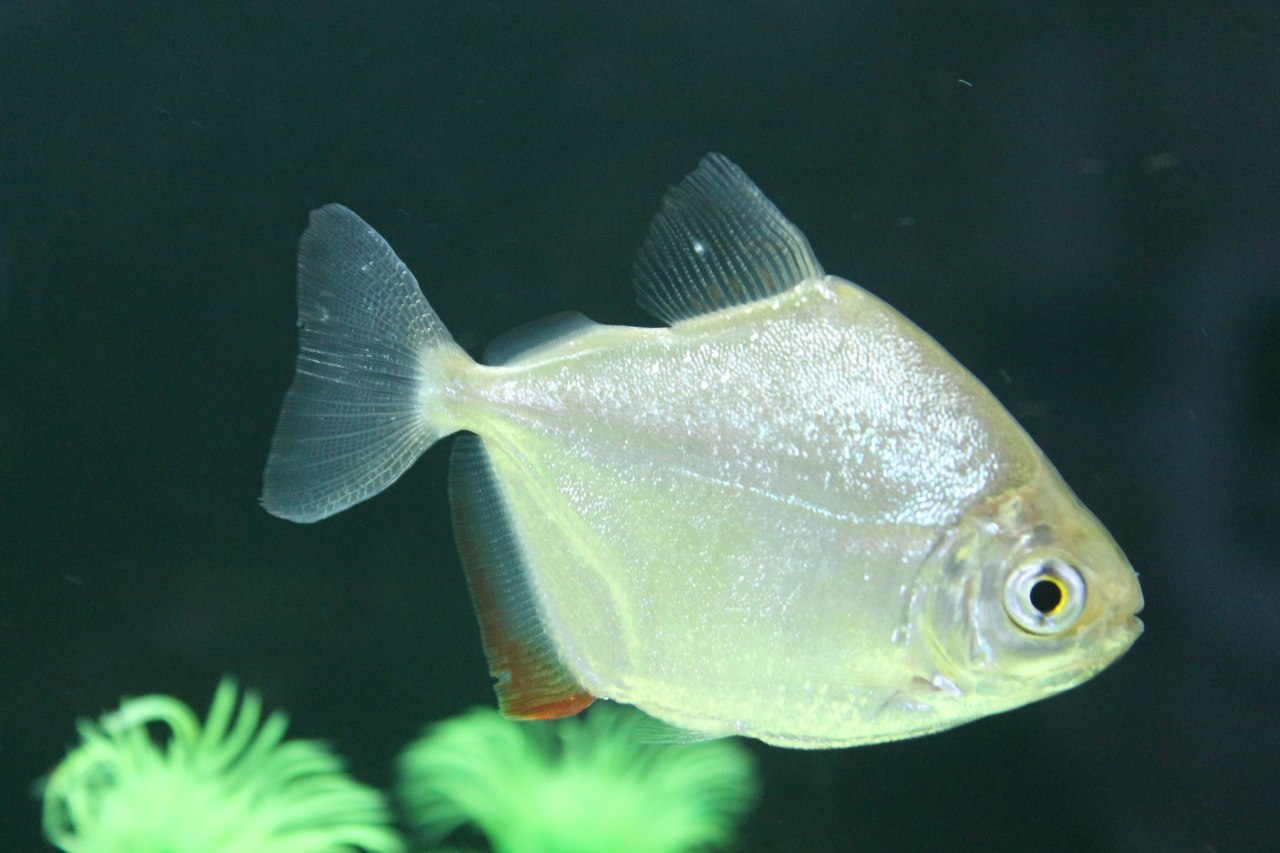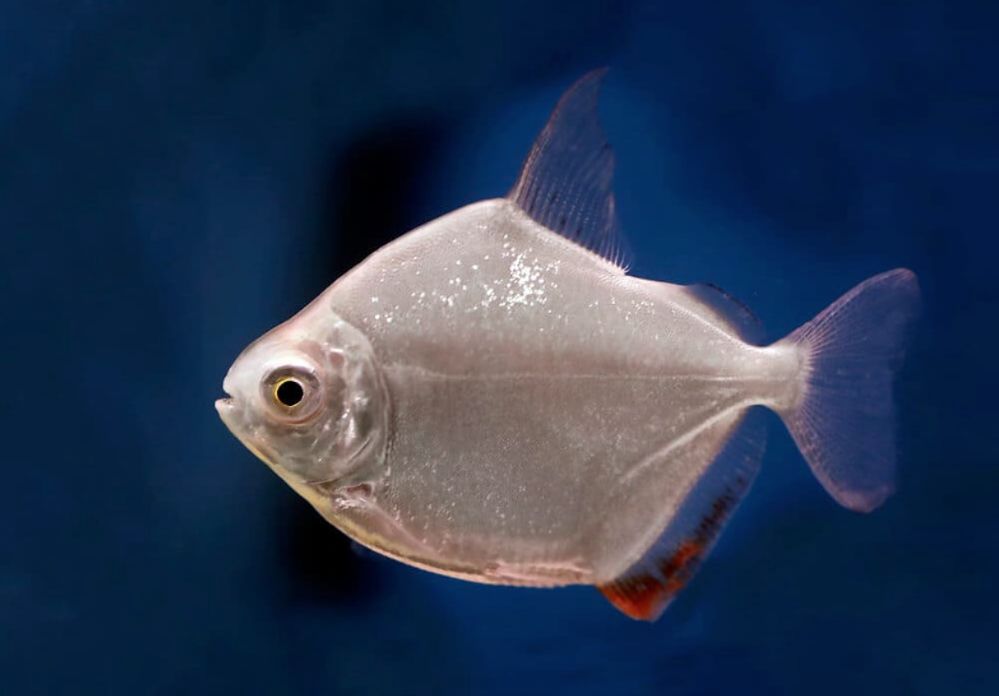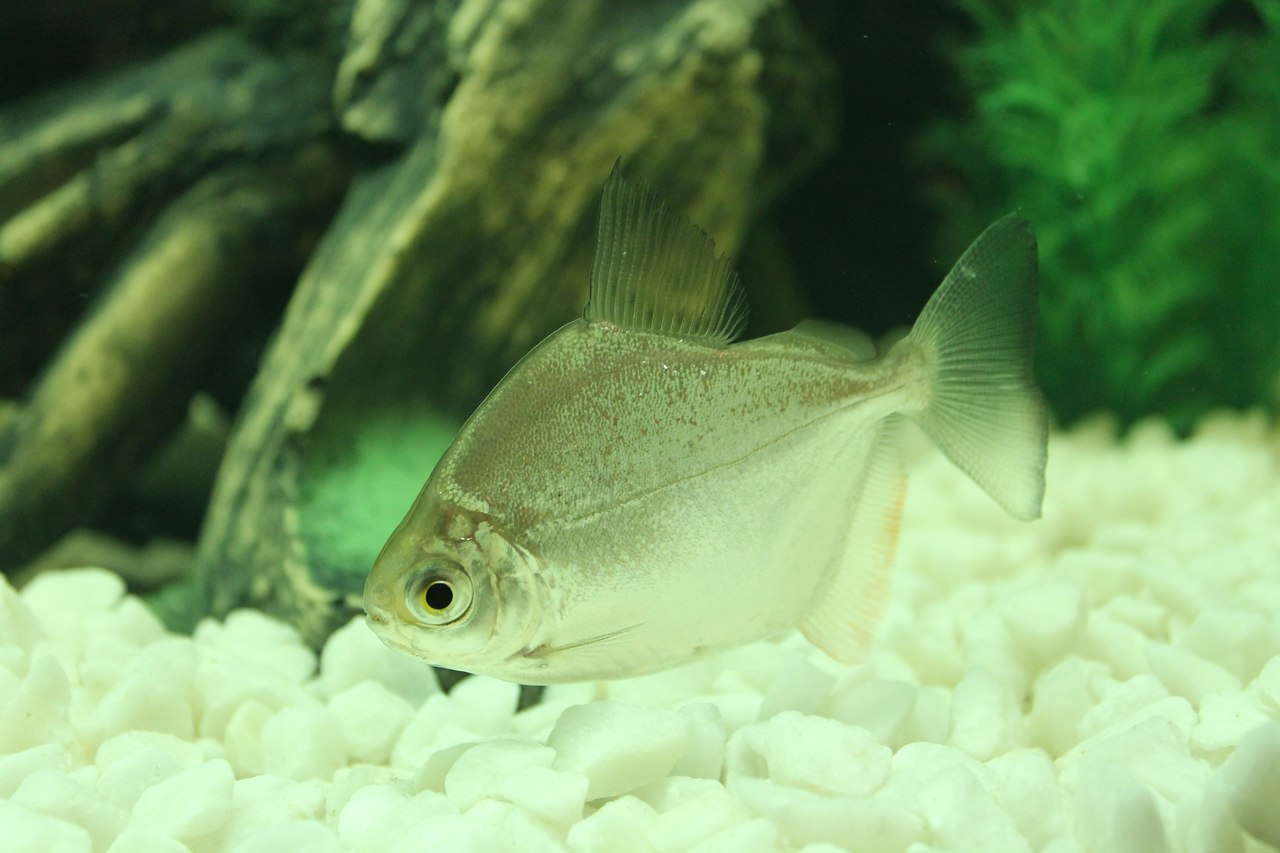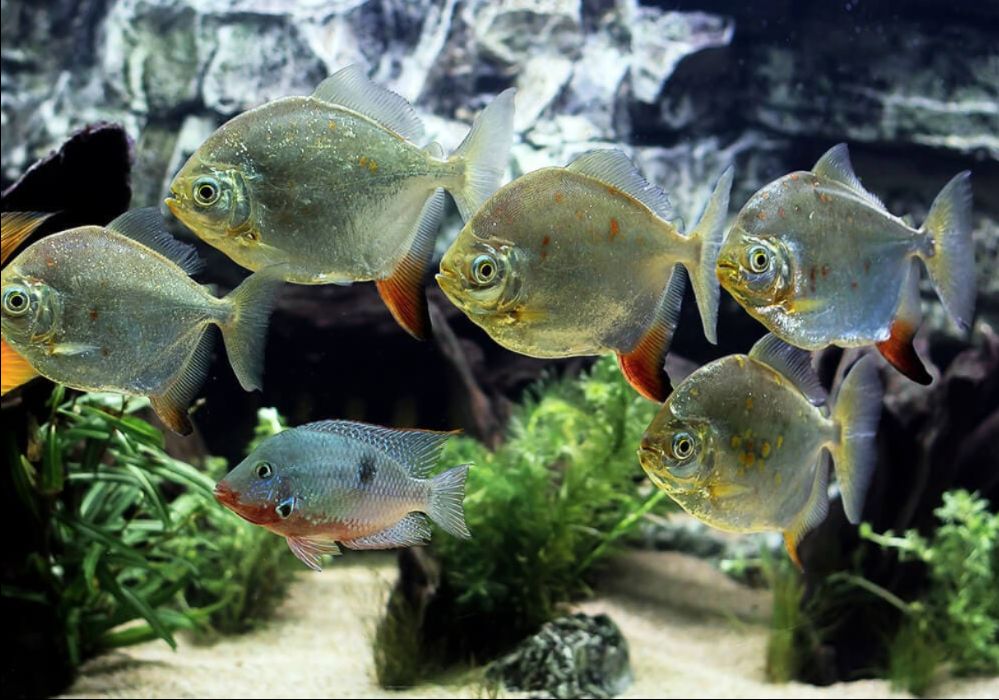Silver dollar fish (lat. Metynnis argenteus) belongs to Characidae family. In the 19th century in the USA there was a coin of 1$ nominal, so it was noticed that the fish juveniles due to their rounded and flattened body shape really may resemble the coin and their silvery coloring only made the likeness stronger.

Contents
Habitat in the wild
The Latin name of the silver dollar fish “argenteus” itself means covered with silver. The silver dollar fish, also known as Metynnis argenteus, belongs to the family Characidae. The Characidae family is a diverse group of freshwater fish commonly found in South America, particularly in the Amazon River basin and other river systems throughout the continent. This family includes many popular aquarium fish, such as tetras and piranhas.
Metynnis argenteus was first described in 1923. The fish inhabits in the Amazon river (South America) – the territory of modern Paraguay and Brazil. In the wild, they inhabit slow-moving or still waters, such as lakes, ponds, and calm sections of rivers and streams. Their natural habitat includes areas with dense aquatic vegetation and submerged tree roots where they can find shelter and food. The water in their native environment is typically warm and soft, with a pH ranging from slightly acidic to neutral. Temperature ranges can vary, but they prefer water temperatures between 75°F to 82°F (24°C to 28°C).
Along with this fish kind you can also see Metynnis hypsauchen in tanks. These two fishes are almost identical in their appearance. Also you may encounter several more kinds of Metynnis on the trade including spotted silver dollar fish – M. lippincottianus. It differs from the previous fish kinds in the numerous rounded gray spots on its body sides.
However, all kinds of Metynnis are alike in their behavior and care. These are schooling fishes, that as a rule inhabit in thickly planted tributaries, where they mainly feed on plant food. In the wild silver dollar fish prefers the latter one, however it’ll gladly feed on protein containing feed.
Description
Size
The silver dollar fish (Metynnis argenteus) is a moderately large freshwater fish commonly kept in home aquariums. When fully grown, they typically reach a size of around 6 to 7 inches (15 to 18 centimeters) in length. However, some individuals may grow slightly larger, up to about 8 inches (20 centimeters).
As with many fish species, the size of silver dollar fish can vary based on factors such as genetics, diet, water quality, and the size of their living environment. Providing them with ample space and a well-balanced diet can help ensure they reach their maximum potential size in a healthy and thriving manner.
Lifespan
The lifespan of silver dollar fish can vary depending on various factors, including their living conditions, diet, and overall care. In ideal conditions, they can live for around 5 to 10 years in captivity. However, some well-cared-for individuals have been known to live slightly longer, possibly up to 12 years or more.
To maximize their lifespan, it’s essential to provide them with a suitable and spacious aquarium, maintain good water quality, and offer a balanced diet that includes high-quality commercial fish food supplemented with occasional treats like live or frozen foods.
Body
The body is tall, laterally flattened and it has rounded and rhombic shape. The coloring is silvery, sometimes with bluish or greenish opalescence. Some species have vertical stripes, but not very pronounced. The fins may be a bit reddish and anal fin of a male is the most brightly colored one.
| Characteristic | Description |
|---|---|
| Scientific Name | Metynnis argenteus |
| Common Name | Silver Dollar fish |
| Family | Characidae |
| Origin | South America (Amazon River basin and surrounding areas) |
| Size | 6 to 7 inches (15 to 18 cm), occasionally up to 8 inches |
| Lifespan | 5 to 10 years, potentially longer with proper care |
| Temperament | Generally peaceful and social |
| Aquarium Size | Minimum 75 gallons (284 liters) for a small group |
| Water Parameters | Temperature: 75°F to 82°F (24°C to 28°C), pH: Slightly acidic to neutral |
| Diet | Omnivorous – plant matter and small protein-based foods |
| Foods | High-quality flakes or pellets, fresh vegetables, live/frozen foods (bloodworms, brine shrimp, daphnia) |
| Tank Environment | Provide ample swimming space, hiding spots, live plants, and driftwood for security and natural behaviors |
| Schooling Behavior | Prefers to be kept in groups of 5 or more |
| Compatibility | Generally peaceful, but monitor tank mates for aggression |
| Breeding Difficulty | Moderate, may require specific breeding conditions |
| Special Considerations | Keep water quality high, avoid overfeeding, and monitor for signs of illness or stress |

Difficulties in keeping
Care is rater easy, since the fish is quite strong and not demanding. It is a large one, so it requires a spacious tank. For the fish owner it’s better to have some experience in keeping some other fish, since for Metynnis school of 4 species a tank from 80 gallons capacity and more is required. Also, keep in mind that tank plants are just feed for this fish.
Keeping in a tank
Tank size
As a general guideline, the minimum recommended tank size for a small group of silver dollar fish is around 75 gallons (284 liters). However, providing them with an even larger tank is even better, especially if you plan to keep a larger group or include other fish in the same aquarium.
A larger tank not only gives them more swimming space but also helps maintain stable water parameters and reduces the risk of aggression among the fish. The additional space also allows you to create a more natural environment with plenty of hiding spots, live plants, and driftwood, which will make the fish feel more secure and comfortable.
If you decide to keep silver dollar fish, consider providing them with a tank that is at least 4 feet (120 cm) in length, which will allow them to exhibit their natural swimming behaviors and thrive in a healthier environment. Always remember to research the specific needs and compatibility of any other fish species you intend to keep with Silver Dollar fish in the same tank.
However, it is active and it can jump, so you’ll have to close the tank tightly and fasten all decorations and equipment in the tank. Large Metynnis species can start tearing around the tank when scared and it can even break the heater, so you’d better not use the glass ones.
Water parameters
As mentioned earlier, silver dollar fish are native to South America, particularly the Amazon River basin, so they prefer water conditions that mimic their natural habitat. Here are the recommended water parameters for keeping silver dollar fish:
- Temperature: The ideal temperature range for silver dollar fish is between 75°F to 82°F (24°C to 28°C). Keeping the water within this range will ensure their metabolism and overall health are optimized.
- pH Level: Silver Dollar fish thrive in slightly acidic to neutral water conditions. The recommended pH range for them is typically between 6.5 to 7.5. However, they can tolerate a pH range of about 6.0 to 7.8.
- Water Hardness: These fish prefer relatively soft to moderately hard water. Aim for a general hardness (GH) level between 4 to 12 dGH (degrees of General Hardness).
- Ammonia, Nitrite, and Nitrate Levels: These parameters are critical for maintaining water quality. Ammonia and nitrite should always be at undetectable levels, as they are toxic to fish. Nitrate levels should be kept as low as possible, ideally below 20 ppm (parts per million).
- Filtration and Water Movement: A good filtration system is essential to keep the water clean and clear. Adequate water movement is also beneficial for maintaining oxygen levels and distributing nutrients evenly throughout the tank.
Regular water testing and maintenance are vital to ensure the water parameters remain stable and within the appropriate ranges. Perform partial water changes (around 25% to 30% of the tank volume) regularly to help keep the water quality in check.
Remember that sudden and drastic changes in water parameters can be stressful or even harmful to the fish. Whenever adjusting water conditions, do so gradually to avoid shocking the fish and other aquarium inhabitants. Monitoring the water parameters regularly and making adjustments as needed will contribute to the overall health and longevity of your silver dollar fish.
Decor
When setting up a tank for silver dollar fish, it’s essential to create an environment that mimics their natural habitat while providing ample swimming space and hiding spots. Here are some decor ideas for a silver dollar fish tank:
- Substrate: Use a fine-grain substrate, such as sand or fine gravel. This will create a natural-looking bottom for the tank and allow the fish to forage comfortably.
- Driftwood: Silver dollar fish appreciate driftwood in their habitat. It not only provides hiding spots but also adds visual interest to the tank. Make sure the driftwood is aquarium-safe and won’t leach harmful substances into the water.
- Live Plants: Keep in mind that Metynnis will eat all the plants in your tank, so it’s better to plant some rigid leaved plants, such as Anubias or some kind of plastic plants.
- Open Swimming Space: Silver dollar fish are active swimmers, so ensure there is plenty of open space in the tank for them to roam freely.
- Lighting: Use soft and subdued lighting to replicate the natural conditions they encounter in their native habitat.
Filtration
Metynnis is rather not demanding and is resistant to diseases, also the silver dollar fish is capable to live in very different tank conditions. All that is important is clean water, powerful filter and regular water renew. The silver dollar fish likes moderate water flow as well and it can be created by means of the filter.

Diet
The interesting thing is that, although the Metynnis is Piranha “cousin”, it unlike the latter feeds mainly on plant food. Flakes with spirulina, lettuce, spinach , cucumbers, squashes are among its favorite feed. When kept in an aquarium, it’s essential to provide them with a well-balanced diet to ensure their health and proper growth.
Here are some recommended foods for silver dollar fish:
- High-quality flake or pellet food: Commercial fish flakes or pellets formulated for herbivorous fish can serve as a staple diet for silver dollars. Look for products that contain a variety of ingredients, including plant matter and protein sources.
- Fresh vegetables: Silver dollars enjoy eating blanched vegetables like spinach, zucchini, lettuce, cucumber, and peas. These vegetables provide essential nutrients and fiber. So if your silver dollar fish diet is mainly vegetable, don’t forget to remove the leftovers from the tank, since they make the water muddy.
- Live or frozen foods: Though fish diet is a plant one, it’ll eagerly eat protein containing food – blood worm, brine shrimp. These protein-rich foods can be offered 1-2 times a week to supplement their diet.
In a community tank silver freshwater fish may become rather timid, so make sure that the silver dollar fish has enough food. Remember to feed them in moderation and avoid overfeeding, as excess food can lead to poor water quality and health issues. Feed them small portions that they can consume within a few minutes, removing any uneaten food to keep the tank clean.
Tank mates
Is a peaceful and active one, but it shouldn’t be kept together with fishes of smaller size, since the latter will be attacked and those the smallest ones will become the fish feed.
They should be kept in a school of at least 4-5 species. Tank mates can be the following: bala shark, giant gourami, sailfin pleco and other large fishes including cichlids, like green terror, blue acara and oscar, convict cichlid, Jack Dempsey.

Gender differences: male vs female
Determining the sex of silver dollar fish (Metynnis argenteus) can be somewhat challenging, especially when they are young and not in breeding condition. However, there are some general differences that can help differentiate between males and females as they mature:
- Size: In some cases, females may be slightly larger and fuller-bodied than males, especially when they are carrying eggs. However, this difference in size is not always reliable and may vary between individual fish.
- Coloration: During breeding periods, male silver dollar fish may exhibit more intense coloration, particularly on their dorsal fin, anal fin, and sometimes on their body. They might develop brighter red or orange hues on these areas to attract females.
- Egg spot: Some male silver dollars have a small, white or yellowish “egg spot” on their anal fin. This spot is thought to mimic the appearance of eggs and can be used to attract females during courtship.
- Behavior: During breeding behavior, males may become more territorial and assertive, while females might become more plump and display a rounder belly when carrying eggs.
It’s important to note that these differences may not be definitive, and the best way to confirm the sex of silver dollar fish is by observing their behavior during breeding periods or by examining their reproductive anatomy, which is often not practical for hobbyists.
If you are interested in breeding silver dollar fish, it’s best to keep a group of them and provide them with suitable breeding conditions. If the fish are in good health and comfortable in their environment, they may eventually exhibit their natural behaviors, making it easier to identify males and females.
Breeding
Dollar fish becomes reproductive when it becomes about 1 year old. Before spawning the fishes that are to breed are removed from their school, put apart in different tanks for about 7-10 days and fed well with plant feed.
A spawning tank should be of at least 40 gallons capacity with fresh and soft water, which hardness doesn’t exceed 4°, pH 6,4-7,0 and the water temperature is 26-30 °C.
You should put some plants in the tank and artificial substrate. Female lays about 300-1000 eggs, they are transparent, not sticky and a bit yellowish. The eggs fall on the tank bottom on the plant leaves.
Breeding the fishes should be removed from the tank, though they don’t tend to da any harm to their eggs.
Eggs incubation period will last about 4-6 days. When juveniles start to swim, they can be fed with brine shrimp and cyclops nauplii, small plankton, milled salad leaves and artificial feed as a start feed.
Juveniles provided with good feed at the age of 6-8 month become of the same size as the adult silver dollar fish.